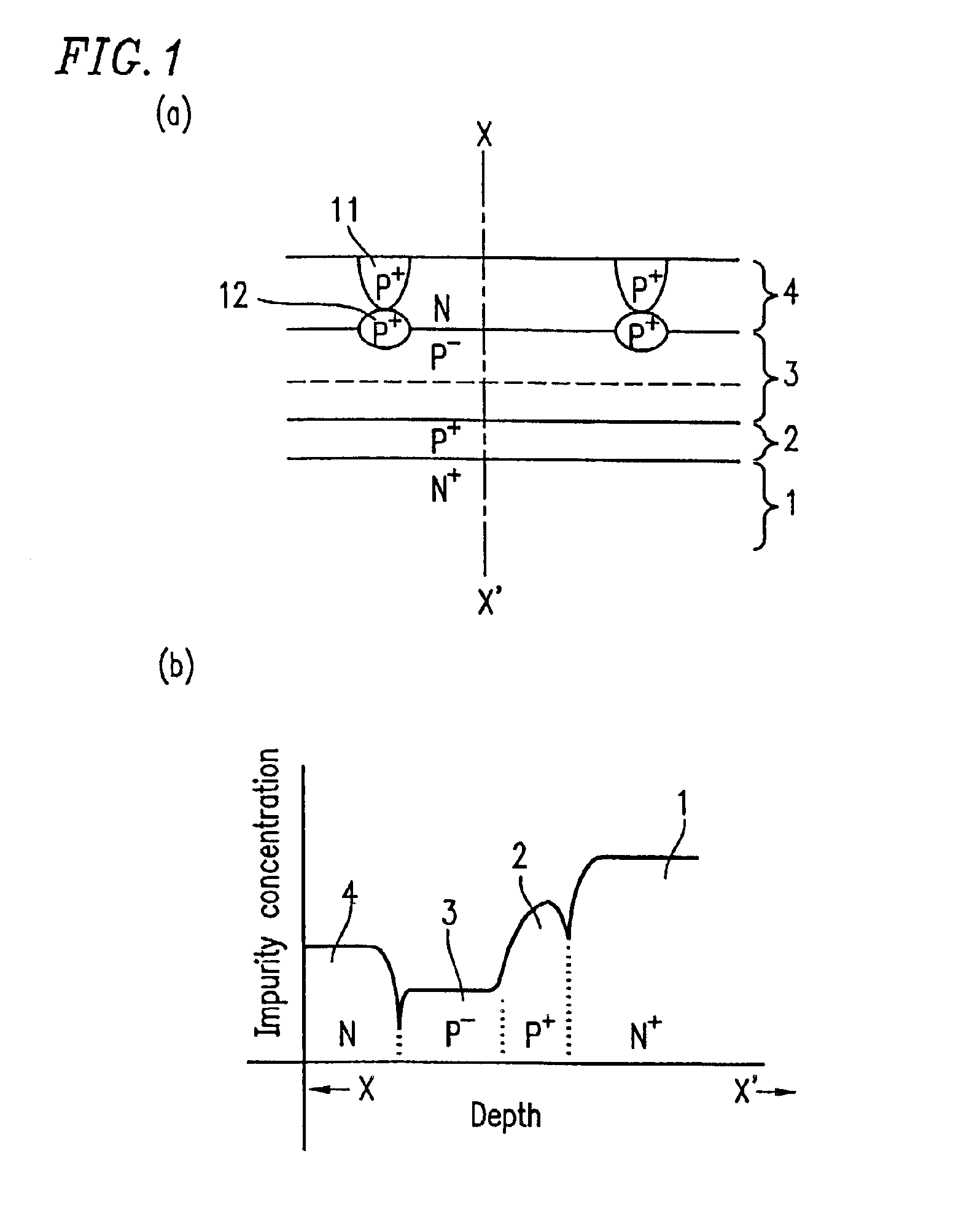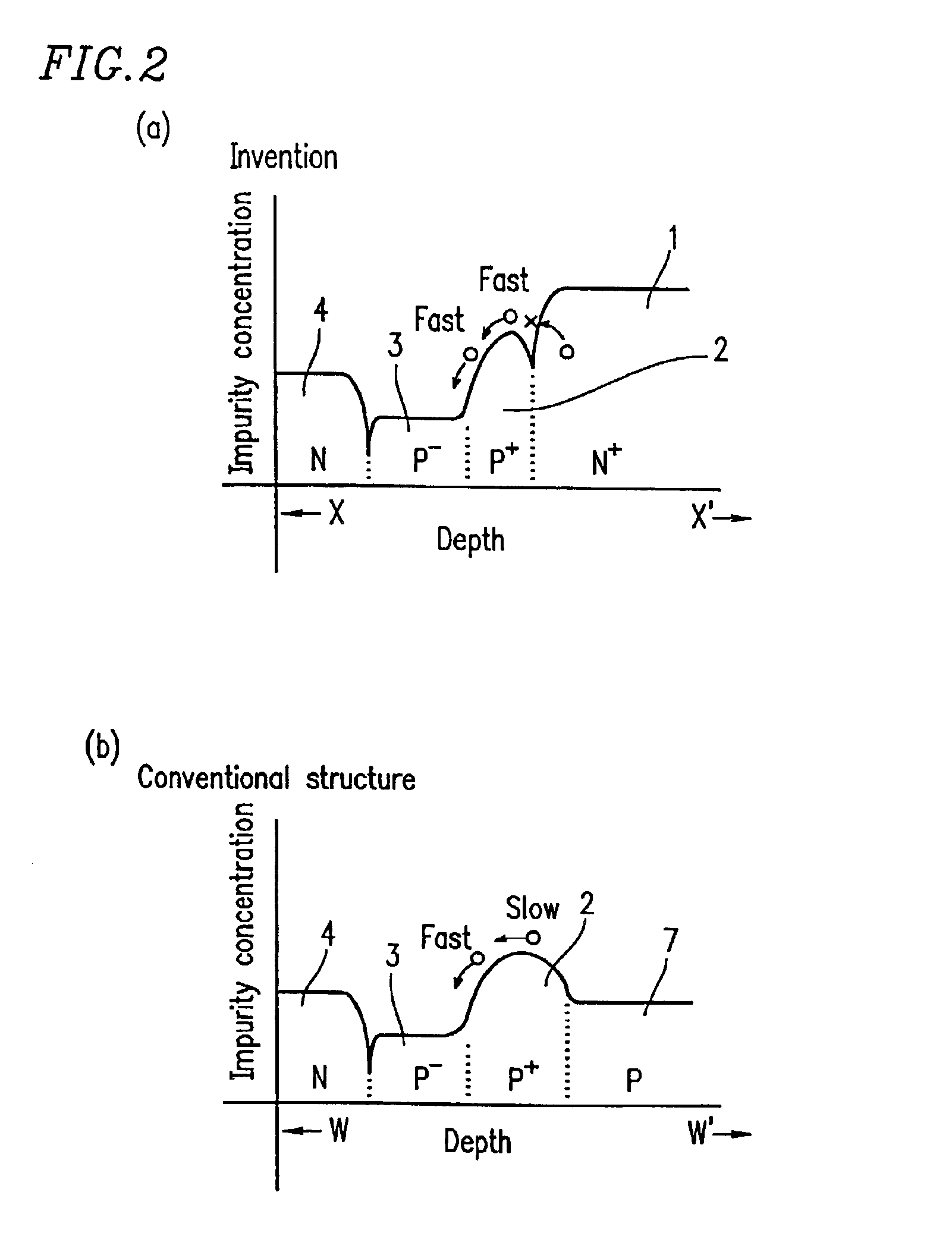Light receiving element, light detector with built-in circuitry and optical pickup
a light receiving element and built-in circuit technology, applied in the direction of optical radiation measurement, radiation controlled devices, instruments, etc., can solve the problems of reducing the response speed of the photodiode, the photodiode is likely to fail to read an address signal immediately, etc., to delay the photoelectric current, the intensity of the internal electric field in this region is increased, and the response speed is reduced
- Summary
- Abstract
- Description
- Claims
- Application Information
AI Technical Summary
Benefits of technology
Problems solved by technology
Method used
Image
Examples
example 1
[0109]FIG. 1A is a cross-sectional view showing a light receiving element (photodiode) according to Example 1 of the present invention. FIG. 1B is a graph showing the impurity concentration on a cross section of the photodiode, taken along line X-X′ in FIG. 1A. Note that in FIG. 1A, an anode electrode, a cathode electrode, signal lines and a surface protection film are not shown.
[0110]The photodiode of FIG. 1A comprises an N+-type semiconductor substrate 1 (first conductivity type semiconductor substrate) having a high impurity concentration, and a P+-type buried diffusion layer 2 (first, second conductivity type semiconductor layer) having a lower impurity concentration than that of the substrate 1, a high resistivity P-type epitaxial layer 3 (second, second conductivity type semiconductor layer) having a lower impurity concentration than that of the P+-type buried diffusion layer 2, and an N-type epitaxial layer 4 (second, first conductivity type semiconductor layer),which are lam...
example 2
[0145]FIG. 4A is a cross-sectional view showing a structure of a light receiving element (photodiode) according to Example 2 of the present invention. FIG. 4B is a graph showing the impurity concentration on a cross section of the photodiode, taken along line Y-Y′ in FIG. 4A. Note that in FIG. 4A, an anode electrode, a cathode electrode, signal lines and a surface protection film are not shown.
[0146]The photodiode shown in FIG. 4A comprises a semiconductor structure comprising a low resistivity P-type semiconductor substrate 7 (second conductivity type semiconductor layer), and an N++-type buried diffusion layer 6 (first conductivity type semiconductor layer) thereon, which has a higher impurity concentration than that of the low resistivity P-type semiconductor substrate 7. On the N++-type buried diffusion layer 6, a P+-type buried diffusion layer 2 having a lower impurity concentration than that of the N++-type buried diffusion layer 6, a high resistivity P-type epitaxial layer 3 ...
example 3
[0164]FIG. 5A is a cross-sectional view showing a structure of a light receiving element (photodiode) according to Example 3 of the present invention. FIG. 5B is a graph showing the impurity concentration on a cross section of the photodiode, taken along line Z-Z′ in FIG. 5A. Note that in FIG. 5A, an anode electrode, a cathode electrode, signal lines and a surface protection film are not shown.
[0165]The photodiode shown in FIG. 5A comprises a semiconductor structure comprising a low resistivity N-type semiconductor substrate 5 (first conductivity type semiconductor layer), and an N++-type buried diffusion layer 6 (first conductivity type semiconductor layer) thereon, which has a higher impurity concentration than that of the low resistivity N-type semiconductor substrate 5. On the N++-type buried diffusion layer 6, a P+-type buried diffusion layer 2 having a lower impurity concentration than that of the N++-type buried diffusion layer 6, a high resistivity P-type epitaxial layer 3 h...
PUM
| Property | Measurement | Unit |
|---|---|---|
| thickness | aaaaa | aaaaa |
| resistivity | aaaaa | aaaaa |
| photoelectric current | aaaaa | aaaaa |
Abstract
Description
Claims
Application Information
 Login to View More
Login to View More - R&D
- Intellectual Property
- Life Sciences
- Materials
- Tech Scout
- Unparalleled Data Quality
- Higher Quality Content
- 60% Fewer Hallucinations
Browse by: Latest US Patents, China's latest patents, Technical Efficacy Thesaurus, Application Domain, Technology Topic, Popular Technical Reports.
© 2025 PatSnap. All rights reserved.Legal|Privacy policy|Modern Slavery Act Transparency Statement|Sitemap|About US| Contact US: help@patsnap.com



